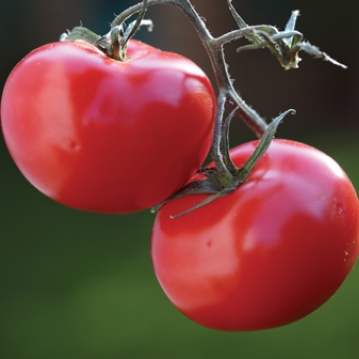
Tomatoes are far and away the most popular vegetable grown by home gardeners. Who can resist the vast array of sizes, shapes, colors, and flavors of hybrid and heirloom tomato varieties? Plus, there’s nothing like walking through your garden and munching on your own home grown fruits in the middle of summer.
Here’s a step-by-step guide to growing tomatoes.
Here’s a step-by-step guide to growing tomatoes.
- Select the Variety – There are hundreds of hybrid and heirloom tomato varieties to choose from. In general, hybrid varieties are more uniform, vigorous, and disease resistant. They grow well almost anywhere in the country. Heirloom varieties offer more variety of fruit shapes, color, and flavor, but sometimes are only regionally adapted. It’s best to grow some of each, trying new varieties each year to see which grow best in your climate. For containers, choose dwarf varieties or determinate varieties. Indeterminate varieties will grow until the weather, insects, diseases, or you stop them. They require the most support but will produce the most fruit. For kids, grow cherry tomatoes for a sweet and plentiful treat.
- Start Seeds Early Indoors – Unless you’re buying transplants at the local garden center, you’ll need to start your tomato seeds indoors 6 to 8 weeks before the last frost date in your area.
- Raise and Warm the Soil – On all but sandy soils, create 8- to 10-inch tall raised beds to grow your tomatoes. Two weeks before transplanting outdoors, cover the beds with red plastic mulch. The color red increases tomato yields by up to 20 percent. Plus it warms the soil, conserves soil moisture, and prevents weeds from growing. In extreme southern areas, use straw mulch or white plastic instead of red plastic to keep the soil from overheating. If using drop irrigation or soaker hoses to water your plants, lay these hoses under the plastic mulch before laying it down.
- Plant – Cut holes in the plastic mulch and plant tomatoes 2- to 3-feet apart in the raised beds. If your seedlings are tall and leggy, bury the stem to the first set of true leaves. Tomatoes have the ability to root along the stem; deeply set plants will be more productive. In containers, mix 3 parts potting soil with 1 part compost and plant one tomato per 5-gallon sized container.
- Keep ‘em Up – Indeterminate tomatoes can grow to be huge plants. Plants trellised off the ground are more productive and have less disease and insect problems on the fruits than plants left to lie on the ground. Use homemade or commercial tomato cages, ladders, or stakes to train them off the ground. Dwarf varieties don’t need support, but determinate varieties do benefit from being trellised.
- Fertilize, Water and Weed – Keep plants well watered, especially when fruit is forming. If the soil moisture fluctuates too much, your fruits may develop blossom end rot (the rotting of the stem end of the fruit). If you haven’t used plastic mulch, consider mulching with straw to keep the soil evenly moist. Mulch also prevents weeds from growing. Fertilize monthly with a handful of an organic 5-5-5 fertilizer sprinkled around the base of the plants to keep the plants productive.
- Control Pests – Watch out for a variety of pests on your tomato plants. Diseases such as wilt, virus, and blight can also cause problems. Select disease resistant varieties. Resistant varieties have the letters of the disease they are resistant to after their name, such as V and F for resistance to verticillium and fusarium wilt.
- Harvest – The more you pick, the more fruits will be produced. Allow the fruits to ripen on the vine to their mature color for the best flavor. Collect mature fruits to can or freeze, preserving the flavor of the harvest into the winter. If you still have many green fruits on your plant at the end of summer, prune off the top the plant and remove newly forming flowers and small fruits. This will send more of the plant’s energy into maturing the remaining fruits. Harvest before a frost.
